Practice Free AZ-104 Exam Online Questions
HOTSPOT
You have an Azure subscription that contains an Azure Backup vault named Backup1, a Recovery Services vault named Recovery1, and the resources shown in the following table.

You plan to back up the resources.
Which resource can be backed up to Backup1, and which resource can be backed up to Recovery1? To answer, select the appropriate options in the answer area. NOTE: Each correct selection is worth one point.
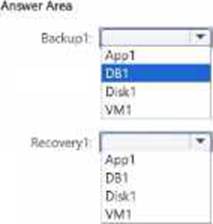

You have an Azure subscription.
You plan to deploy a container.
You need to recommend which Azure services can scale the container automatically.
What should you recommend?
- A . Azure Container Apps only
- B . Azure Container Instances only
- C . Azure Container Apps or Azure App Service only
- D . Azure Container Instances or Azure App Service only
- E . Azure Container Apps, Azure Container Instances, or Azure App Service
HOTSPOT
You have an Azure subscription that contains the resources shown in the following table:

You assign a policy to RG6 as shown in the following table:

To RG6, you apply the tag: RGroup: RG6.
You deploy a virtual network named VNET2 to RG6.
Which tags apply to VNET1 and VNET2? To answer, select the appropriate options in the answer area. NOTE: Each correct selection is worth one point.
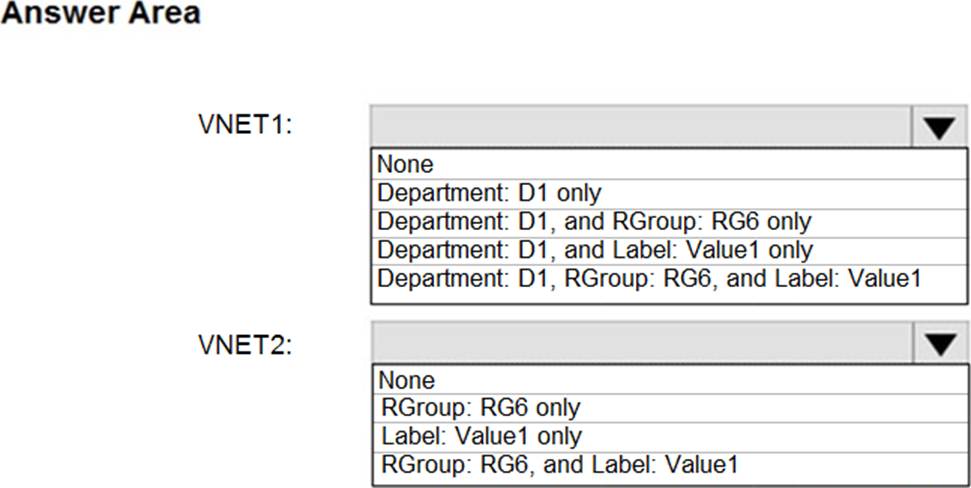
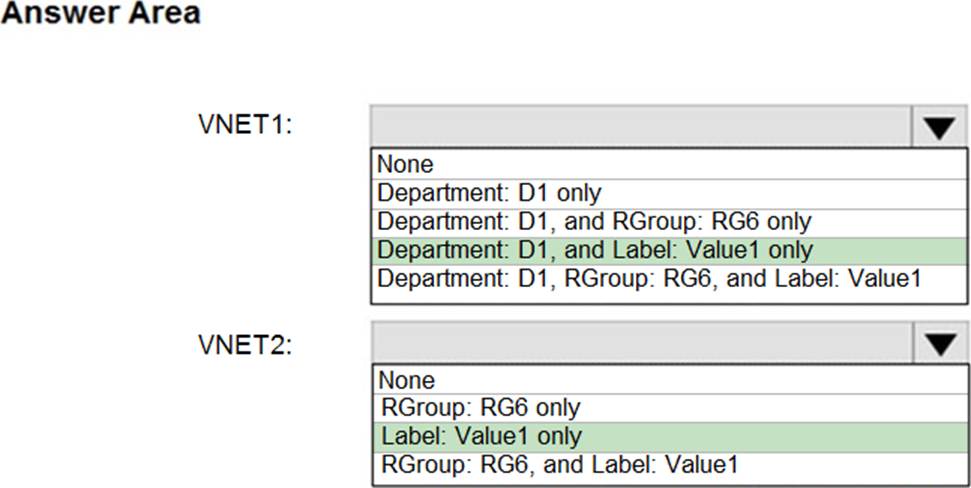
Explanation:
https://learn.microsoft.com/en-us/azure/azure-resource-manager/management/tag-policies
You have an Azure subscription that contains.
The storage accounts shown in the following table.
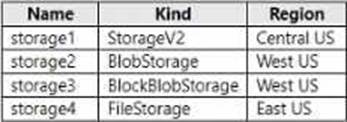
You deploy a web app named Appl to the West US Azure region.
You need to back up Appl. The solution must minimize costs.
Which storage account should you use as the target for the backup?
- A . storage1
- B . storage2
- C . storage3
- D . storage4
D
Explanation:
To back up a web app, you need to configure a custom backup that specifies a storage account and a container as the target for the backup1. The storage account must be in the same subscription as the web app, and the container must be accessible by the web app2. The backup size is limited to 10 GB, and the backup frequency can be configured to minimize costs.
According to the table, storage1 is the only storage account that meets these requirements. Storage1 is in the same subscription and region as the web app, and it is a general-purpose v2 account that supports custom backups. Storage2 and storage3 are in a different region than the web app, which may incur additional costs for data transfer. Storage4 is a FilesStorage account, which does not support custom backups.
Therefore, you should use storage1 as the target for the backup of your web app. To configure a custom backup, you can follow these steps:
In your app management page in the Azure portal, in the left menu, select Backups.
At the top of the Backups page, select Configure custom backups.
In Storage account, select storage1. Do the same with Container.
Specify the backup frequency, retention period, and database settings as needed.
Click Configure.
At the top of the Backups page, select Backup Now.
You have an Azure subscription. The subscription contains virtual machines that run Windows Server. You have a data collection rule (DCR) named Rule1
You plan to use the Azure Monitor Agent to collect events from Windows System event logs.
You only need to collect system events that have an ID of 1001.
Which type of query should you use for the data source in Rulel?
- A . SQL
- B . KQL
- C . XPath
C
Explanation:
When configuring a Data Collection Rule (DCR) in Azure Monitor to collect Windows Event Logs using the Azure Monitor Agent (AMA), and when you need to filter specific events (like those with a particular Event ID), you must use a filter expression compatible with the data source.
For Windows Event Logs, XPath is the supported query language used to filter specific entries, such as filtering events by ID (e.g., EventID=1001).
You have an Azure subscription that contains the resources in the following table.

VM1 and VM2 are deployed from the same template and host line-of-business applications accessed by using Remote Desktop.
You configure the network security group (NSG) shown in the exhibit. (Click the Exhibit button.)

You need to prevent users of VM1 and VM2 from accessing websites on the Internet.
What should you do?
- A . Associate the NSG to Subnet1.
- B . Disassociate the NSG from a network interface.
- C . Change the DenyWebSites outbound security rule.
- D . Change the Port_80 inbound security rule
A
Explanation:
Outbound rule “DenyWebSites” is setup correctly to block outbound internet traffic over port 80. In the screenshot it states, "Associated with: 0 subnets, 0 NIC’s", so you need to associate the NSG to Subnet1.You can associate or dissociate a network security group from a NIC or Subnet.
Reference: https://docs.microsoft.com/en-us/azure/virtual-network/manage-network-security-group
HOTSPOT
You have an Azure subscription linked to a hybrid Microsoft Entra tenant.
The tenant contains the users shown in the following table.

You create the Azure Files shares shown in the following table.
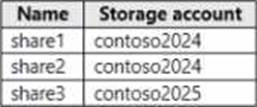
You configure identity-based access for contoso2024 as shown in the following exhibit.
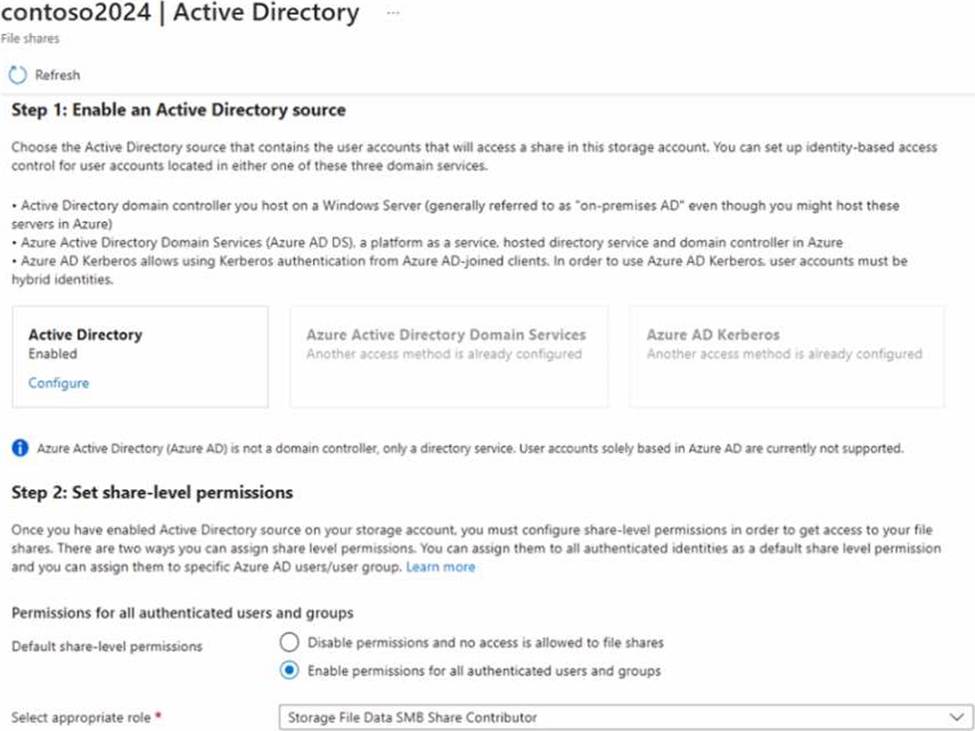
For each of the following statements, select Yes if the statement is true. Otherwise, select No. NOTE: Each correct selection is worth one point.
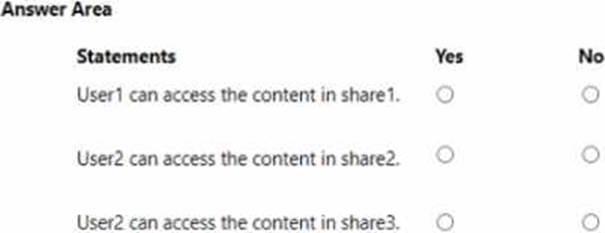
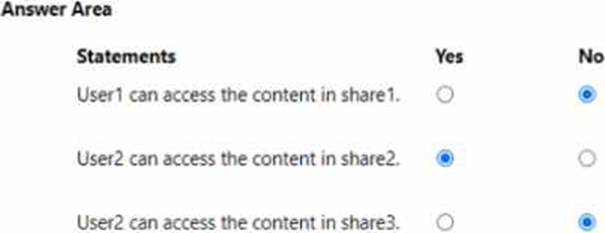
You have an Azure subscription.
You plan to create a storage account named storage1.
You need to configure a deny assignment for storage1.
What should you use?
- A . an Azure Resource Manager (ARM) template
- B . Azure Policy
- C . a landing zone
- D . a deployment stack
You have an Azure subscription named Subscription 1 and an on-premises deployment of Microsoft System Center Service Manager Subscription! contains a virtual machine named VM1.
You need to ensure that an alert is set in Service Manager when the amount of available memory on VM1 is below 10 percent.
What should you do first?
- A . Create a notification.
- B . Create an automation runbook.
- C . Deploy the IT Service Management Connector (ITSM).
- D . Deploy a function app
C
Explanation:
IT Service Management Connector (ITSMC) allows you to connect Azure to a supported IT Service Management (ITSM) product or service. Azure services like Azure Log Analytics and Azure Monitor provide tools to detect, analyze, and troubleshoot problems with your Azure and non-Azure resources. But the work items related to an issue typically reside in an ITSM product or service. ITSMC provides a bi-directional connection between Azure and ITSM tools to help you resolve issues faster. ITSMC supports connections with the following ITSM tools: ServiceNow, System Center Service Manager, Provance, Cherwell.
Reference: https://docs.microsoft.com/en-us/azure/azure-monitor/alerts/itsmc-overview
You have an Azure subscription that contains a storage account named storageacct1234 and two users named User1 and User2.
You assign User1 the roles shown in the following exhibit.
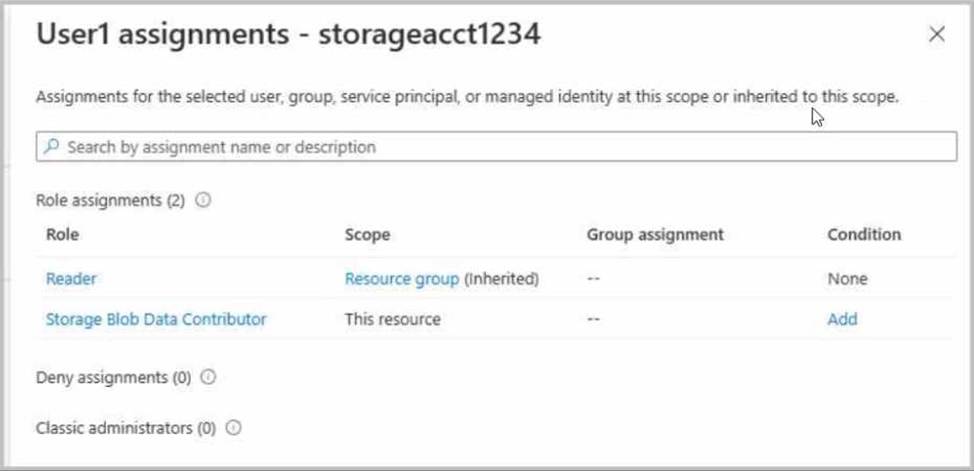
Which two actions can User1 perform? Each correct answer presents a complete solution. NOTE: Each correct selection is worth one point.
- A . View file shares in storageacct1234.
- B . Upload blob data to storageacct1234.
- C . Assign roles to User2 for storageacctl234.
- D . View blob data in storageacctl234.
- E . Modify the firewall of storageacct1234.
